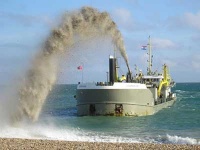Dr Laurence Hopkinson and Dr Kevin Stone from the School of Environment and Technology at Brighton University will be working with Association Francaises des Ports Locaux de la Manche and with ports including Newhaven, Shoreham, Fowey, Poole, Plymouth, Falmouth, Le Havre, Cherbourg and Brest.
The main problem with dredged sediment is what to do with it and options depend on the level of contamination. If it is sand or gravel it can be cleaned and reused as aggregate but if the material is fine-grained silts and clay then it is often deposited in landfill sites, which is not environmentally friendly. It could be decontaminated or mixed with and locked inside cement, but these solutions are costly.
The €5m (£4.5m) funding is from the EU programme INTERREG IVA and the project, called SETARMS (Sustainable Environmental Treatment and Reuse Marine Sediments), aims to determine the level and type of contamination at the ports and to develop strategies to treat and stabilise the sediment. It will run until 2013 and will involve seven of the university’s staff and two new researchers.
Dr Stone said: ‘Clearly the more material that can be treated and reused, the less that has to go to disposal and thus the environmental impact is greatly reduced.’

The ship Sospan Dau dredges Channel ports. It is pictured dredging a beach in shallow water off Hayling Island and discharging a spray, a process called ‘rainbowing’





Nanogenerator consumes CO2 to generate electricity
Nice to see my my views being backed up by no less a figure than Sabine Hossenfelder https://youtu.be/QoJzs4fA4fo